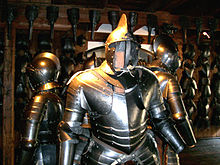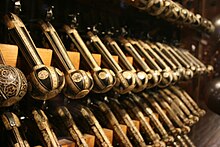State Armory
The Landeszeughaus in Graz was built between 1642 and 1647 and was once the central arms depot in Styria. The weapons and accessories stored in it were used to equip the Styrian state contingent and to supply the military border established to defend the Ottoman Empire in the 16th century in today's Croatia and Hungary. With its 32,000 exhibits of all kinds, the state armory is the largest armory in the world, which has largely been preserved in its original state. Today the house is part of the Universalmuseum Joanneum and attracts thousands of tourists and lovers of historical weapons from all over the world every year.
history
In 1551 , the name Zeughaus was first used in a document to refer to those rooms in which the countryside deposited its weapons. These were located in the old country house and at the Graz city gates. When the country house was rebuilt in 1565, the weapons were stored in the spacious attics. The increasing military threat led to a heyday of arms production and the construction of today's armory from 1642 to 1644 according to plans by Anton Solar. Equipment for 16,000 men was stored and maintained here. However, the state armory itself lost more and more of its importance after its construction, and since a relatively stable border with the Ottoman Empire was established after the Peace of Karlowitz in 1699 , the main task of the armory was to arm the mercenaries on the military border in Croatia / Hungary , no longer necessary to this extent. Although the armory was still in use, the building was closed in 1749 and the entire inventory was to be closed and brought to Vienna. This initiative came from Maria Theresa , who in the course of her reforms also reformed and centralized the army in the hereditary lands.
The estates were able to convince the empress of the ideal value of the armory, and so the armory and its furnishings were preserved as a complete ensemble and actually the oldest museum in Styria. In 1892 it was incorporated into the Universalmuseum Joanneum .
During the Second World War the museum was evacuated and all weapons were brought to three remote Styrian castles. With the help of the British occupying forces, the return transport took place without any losses. The state armory was able to be reopened in April 1946.
On March 22, 2013, the largest renovation since the armory was built was completed. The entrance area was redesigned and the armory made barrier-free.
Present stock
Today, the armory in Graz houses around 32,000 exhibits, the world's largest collection of protective weapons (around 3,840 armor , helmets , ring armor and shields ), edged weapons (2,414 pieces), polearms (5,395 pieces), rifles (3,867 pieces), pistols ( 4,259 pieces) and weapon accessories of all kinds (including 3,449 powder and fuse bottles as well as cartridge quivers ). With this stock it would still be possible to equip around 5,000 men. The main focus is on pieces of armor and weapons for ordinary foot and horsemen from the 16th and 17th centuries. But there are also officers' weapons in the collection, which - often richly decorated - come from workshops in Innsbruck , Augsburg or Nuremberg . Showpieces are among others:
- the Küriss of Archduke Charles II of Inner Austria ; made by Conrad Richter, Augsburg around 1565
- the horse harness by Konrad Seusenhofer , Innsbruck around 1510
- the splendid armor from Michael Witz d. J. , Innsbruck around 1550
literature
- Peter Krenn : The Landeszeughaus in Graz. Publishers Bonechi and Styria, Florence – Graz – Lahn in Limburg / Lahn 1991, ISBN 3-222-11719-5 .
Web links
Individual evidence
- ↑ On the history of the Landeszeughaus
- ↑ Grazer Zeughaus barrier-free after 22 years
- ^ Landeszeughaus Graz now has a lift
- ↑ Peter Krenn: Harnisch and helmet. Landeszeughaus Graz at the Styrian State Museum Joanneum. German English. Kunstverlag Hofstetter, Ried im Innkreis 1987, p. 4.
- ↑ a b Peter Krenn: Sword and Spear. Landeszeughaus Graz at the Styrian State Museum Joanneum. German English. Kunstverlag Hofstetter, Ried im Innkreis 1997, p. 4.
- ↑ a b c Peter Krenn: Rifle and Pistol. Rifles and Pistols. Landeszeughaus Graz at the Styrian State Museum Joanneum. Kunstverlag Hofstetter, Ried im Innkreis 1990, p. 4.
Coordinates: 47 ° 4 ′ 10.7 ″ N , 15 ° 26 ′ 22.9 ″ E






